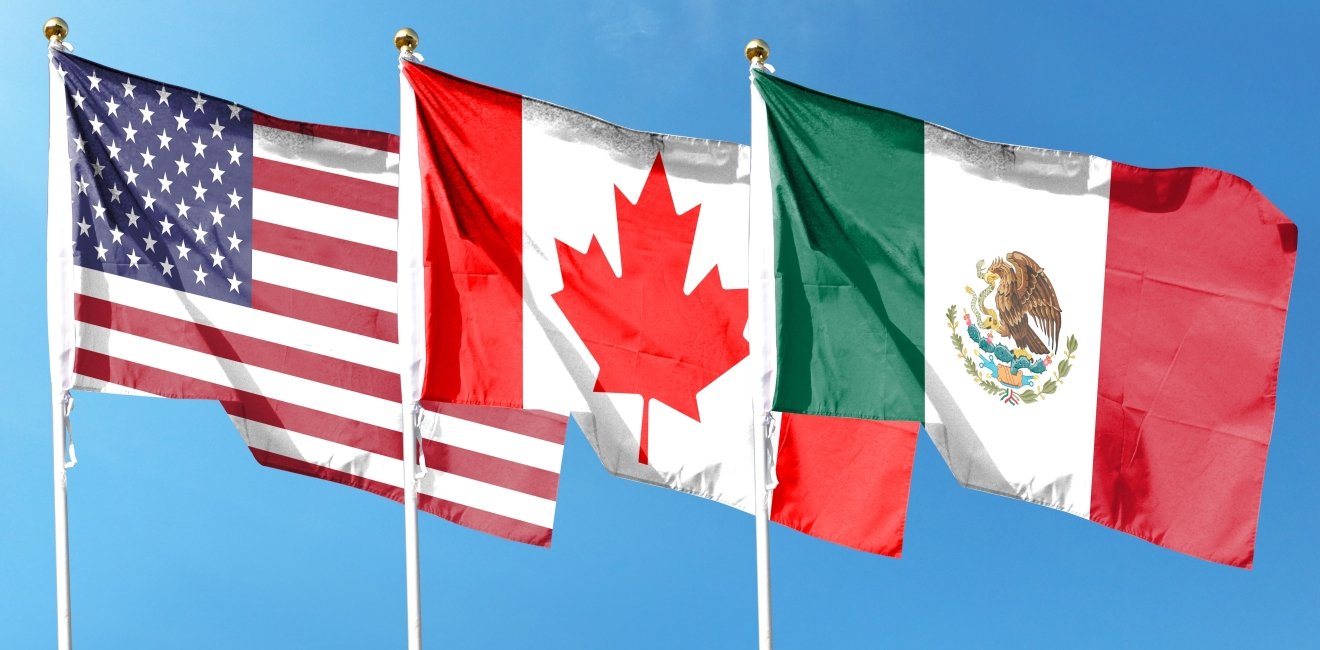Experts were invited to respond to one of the following prompts.
• What lessons should we learn from NAFTA as we look forward to the 2026 USMCA review conference?
• How has North American integration impacted you (personally and/or professionally)?
• What is missing/what more needs to be done to create a truly integrated region?
• Should USMCA be expanded, and if so, under what conditions and to which parties?
Has the Time Come Now for a Grand Envision?
Hon. Jean Charest
Canada Institute Advisory Board Member; Partner, McCarthy Tétrault LLP; Former Premier of Québec
As one of the most prominent free trade agreements of its time, NAFTA’s legacy persists. It played a major role in shaping subsequent trade agreements around the world and, at what would be its 30th anniversary, it continues to illuminate important lessons. A question that emerges is whether, as an innovative agreement, and followed by CUSMA, it should be the tool of reference when developing new architecture for a free trade agreement with other partners, namely the European Union and the United Kingdom. The agreement could be expanded to encompass environmental, labor, and human rights, cultural exchanges, labor mobility, and education. Building strong partnerships will create powerful leverage between our economies and emerging ones. To achieve this, American leadership is essential, as this sizeable partnership that spans North America is not possible without their participation. The important lesson here is that without a project urging these relationships forward, we risk regressing.
Overlooked Issue and Unfinished Business
James A. Haley
Canada Institute Global Fellow; Former IMF Director for Canada, Ireland, and the Caribbean
The NAFTA is widely regarded a resounding success. Trade volumes increased by far more than trade models predicted at the time. NAFTA also had far-reaching effects in that it signaled the start of a veritable race to freer—if not free—trade around the globe. From about 40 regional trade agreements in 1994, the total number of such arrangements soared to 170 a decade later. By unleashing productivity gains, this surge of trade liberalization fostered a period of strong growth and low inflation—the “Great Moderation”—interrupted only by the global financial crisis in 2008.
Meanwhile, fears of widespread job losses articulated in Ross Perot’s jeremiad that NAFTA would lead to a “giant sucking sound” from employment shifting from the US to Mexico were wildly misplaced. This outcome is a useful reminder that an economy in which wages and prices are flexible and competitively determined will gravitate to full employment: Although trade liberalization may result in short-term job losses as low value-added sectors contract, those workers should eventually be absorbed by expanding high-value sectors that offer higher wages.
Analysis of the long-term effects of NAFTA is hampered, however, by the fact that, while economic theory is built on the ceteris paribus assumption that other factors are held constant, this condition rarely holds when it comes to policy evaluation.
Viewing NAFTA through the lens of its effect on the global trading system, for example, highlights a key issue overlooked in the process leading to NAFTA—income distribution. In this respect, the move towards freer trade over the past three decades, culminating in China’s accession to the WTO in 2001, has coincided with a steady increase in inequality in the advanced economies. Firms forged global supply chains with high value-added activities (innovation, engineering, and marketing) concentrated in high-wage, high-skill countries, and input manufacturing and assembly outsourced to low-wage, low-skilled countries. In the US, real wages of less-skilled labor have largely stagnated as globalization shifted production to low-wage countries and increased the returns on capital.
Such effects are broadly consistent with the predictions of traditional factor proportions trade models and, in theory, policies under which “winners” of trade liberalization compensate the “losers” could have ensured that all were made better off. The introduction of the NAFTA Transitional Adjustment Assistance and the Trade Adjustment Assistance programs demonstrates efforts were made in this regard. In practice, however, these measures are designed to help workers find new employment—not compensate for lower earnings—and the shift from high-wage manufacturing jobs to low-wage service sectors jobs is a key stylized fact across most advanced economies.[1]
NAFTA also embodied strong protections to capital investment that were incorporated in subsequent trade agreements. And while these provisions were intended to create favourable environments for investment, they may have had unintended effects with respect to distribution. In part, this is because increasing the mobility of capital strengthened capital’s bargaining power with respect to labor, allowing firms to abrogate implicit contracts between firms and workers via outsourcing and offshoring or cancellation of non-wage benefits previously provided at the discretion of management.
Moreover, increased capital mobility enables businesses to avoid tax liabilities by moving operations offshore. Investment protections may have thus exacerbated inequality through the tax system. With international tax competition limiting corporate taxation, governments face a Hobbesian choice: raise taxes on households and/or reduce critical public services, on the one hand, or raise corporate taxes and lose employment and the corporate tax base on the other hand. Whatever the choice, the result is unambiguously negative in terms of income inequality.
Measured by the traditional metrics of trade volumes and price effects, the benefits of NAFTA are positive. But the agreement should not be assessed in isolation. It was a pathbreaking arrangement that rewrote the rule book for international trade. And while it facilitated the development of global supply chains that produced those benefits, it also likely contributed to greater income inequality that has deepened political fissures across the advanced economies. Addressing those effects so that the economy is viewed as delivering to all workers, so the gains from trade liberalization are preserved, is the unfinished business of trade policy.
[1] At the time, the predictions of traditional trade models with respect to income distribution may have received insufficient consideration because of the prevailing dominance of “new” trade models based not on factor proportions but on imperfect competition. While these models may have applied to intra-industry trade between countries of similar levels of economic development, such as Canada and the United States, they were less relevant with respect to US-Mexico trade patterns; and were largely irrelevant to the analysis of China’s entry to the global trade system.
Labor Rights, Still an Unfulfilled Promise
Carlos A. Heredia
Associate Professor, Centro de Investigación y Docencia Económicas (CIDE); Global Fellow & Advisory Board Member, Mexico Institute
Three decades into NAFTA, now named USMCA, the three partners have moved from liberalization of trade, capital flows, and foreign direct investment, into shared production.
However, there is one missing component: there has been no progress on labor mobility.
A landmark report reminds us that “Mexico and the United States have lacked a bilateral agreement to regulate cross-border labor mobility since 1965. Half of the Mexican-born individuals in the US do not have legal authorization.” The report provides a blueprint for a bilateral agreement that is designed to “end unlawful migration, promote the interests of US and Mexican workers, and uphold the rule of law.” It implies retrieving labor circularity, which would allow Mexican workers to toil in the United States while keeping their permanent residence in Mexico.
Although work visas are granted to qualified personnel and essential workers, these are far from enough to enhance legal pathways in a period of acute labor shortages in North America. During the pandemic, numerous undocumented agricultural and service workers were hailed as “essential” and irreplaceable, but there was no progress in their regularization nor in their labor stability.
While robotics and automation can sometimes substitute when there is a scarcity of workers, there are many cases where substitution is not technically feasible, and others where workers are needed to complement automation.
Much of the so-called “immigration problem” stems from undocumented immigration, rather than from immigration itself. “Illegal immigration is the natural consequence of the conflict between the United States´ thirst for foreign labor and its strict immigration laws, which have created a permanent class of disenfranchised ‘illegal’ workers” writes Marcela Valdés in the New York Times Magazine.
In the United States, under the Immigration and Nationality Act (INA), it is illegal to discriminate against any worker, regardless of immigration or citizenship status. For all the Biden Administration’s talk about upholding labor rights in Mexico, the case of Mexican migrant workers in the United States has been totally put aside by both governments. The US economy has become addicted to cheap labor. Several million Mexican day laborers, working in the agricultural, construction and service industries toil under dire conditions, an indignity in a region that prides itself to be “the world's most competitive.”
The reason is, in the United States, all economic, trade, and immigration policy are US national security policy. In the current political atmosphere, one would face considerable odds demanding protection of the labor rights of undocumented Mexican workers, even though they have rejuvenated and supplemented the US labor force and helped pay for baby boomer pensions. In a rational political environment, the conversation would have to shift towards regulated labor mobility and the conformation of a unified labor market in North America. Fair treatment of workers is sound public policy and good business practice.
The Review Provisions: an Ace for North American Trade
Hon. Bruce Heyman
Co-Chair, Canada Institute Advisory Board; Co-founder, Uncharted LLC; Former Ambassador of the United States to Canada
Both the NAFTA and now the USMCA have played significant roles in promoting trade and economic growth between the United States, Canada, and Mexico. As the former US Ambassador to Canada, I witnessed firsthand the positive impact of North American trade on various sectors and industries.
NAFTA, which was signed in 1994, eliminated tariffs and trade barriers among the three countries, facilitating the flow of goods and services. It has been credited with boosting regional competitiveness, increasing cross- border investment, and creating jobs. The new USMCA, which replaced NAFTA in 2020, builds upon its predecessor by addressing modern trade challenges, such as digital trade, labor standards, environmental protection, and intellectual property rights.
While USMCA has a specific dispute settlement mechanism, one of the key features of USMCA is its review provisions, which ensure continuous evaluation of the agreement's implementation and effectiveness. This allows for necessary adjustments to be made to address emerging issues and ensure compliance with the intended goals of the agreement. It demonstrates a commitment to ongoing improvement and adaptability in the face of changing circumstances.
The review provisions in the new USMCA are of great importance for the next US administration as they provide a mechanism for assessing and addressing any emerging issues or challenges that may arise in relation to the agreement. By conducting regular reviews, the administration can ensure that both the legality and the spirit of the agreement are being upheld by all parties involved.
These review provisions allow the administration to closely monitor the implementation of the USMCA and identify any areas where compliance may be lacking. This ensures that the agreement is being followed by all parties in the intended manner and helps prevent any violations or unfair practices that could harm the interests of the United States. The reviews also provide an opportunity for the administration to engage with its counterparts in Canada and Mexico to address any concerns or inconsistencies that may arise.
Furthermore, the review provisions enable the administration to adapt and adjust the agreement as needed. The global trade landscape is constantly evolving, and it is important for the United States to be able to respond to changing circumstances to maximize the benefits of the USMCA. By conducting regular reviews, the administration can identify any areas where the agreement may need to be modified or improved to better serve the interests of the United States.
In summary, the review provisions of the new USMCA are crucial for the next US administration as they allow for continuous assessment and improvement of the agreement. These provisions ensure compliance with both the legality and spirit of the agreement, while also providing flexibility to address any emerging issues or challenges. By actively engaging in the review process, the administration can strengthen the effectiveness of the USMCA and ensure that it serves the best interests of the United States.
USMCA Analyzed Through Charlie Munger's Lens
Guillermo Jasson
Partner at Sterling Legacy, Chair of the Woodrow Wilson Mexico Institute Strategy Committee, and Chair of the Tuck Latin America and Caribbean Council at Dartmouth College
Charlie Munger, a savvy investor who recently passed away, advocated for the practice of “inversion”—looking at problems in reverse to better understand and avoid negative outcomes. As we approach the 30th anniversary of the NAFTA, it prompts us not only to reflect on its impact, but also to employ “inversion” in assessing the negative outcomes to be avoided under the USMCA. At the forefront is the risk of eroding North American competitiveness if the USMCA fails to encapsulate the critical elements necessary to counterbalance China's growing global influence.
Possible negative outcomes to be avoided:
Losing North American competitiveness
USMCA must avoid losing competitiveness against global economic giants like China. Therefore, it should strategically combine the robust capital markets of the United States, Mexico's competitive labor costs and near-shoring capabilities, North American legal jurisdiction and infrastructure, US-M-C’s large combined internal market, and Silicon Valley's technological innovations. Inverting the perspective emphasizes the need for the USMCA to prioritize collaborative initiatives, to capitalize on the individual strengths that each country brings to develop a formidable global competitor.
Decoupling Mexican economy from the US and creating political instability
Beyond economic concerns, there's a more profound risk associated with Mexico's development. If the USMCA doesn't act as a catalyst for Mexico's growth, it could lead to a cycle of economic stagnation, weakening its rule of law, and deepening poverty. A prosperous Mexico provides fewer incentives for its citizens to seek opportunities elsewhere, contributing to a more stable North American region.
Moreover, the potential political consequences of a faltering USMCA in Mexico are substantial. A failure to spur economic growth may fuel political discontent, opening the door to a leftward shift in governance. This shift, if reminiscent of Venezuela's trajectory, brings forth a host of concerns such as refugee crises, arms trafficking, and a surge in drug-related issues like the trafficking of fentanyl. Inverting the perspective underscores the interconnectedness of North American stability, emphasizing the importance of Mexico's trajectory in preventing such negative externalities.
Other negative by-product effects on energy, natural resources, and the environment
Indiscriminate exploitation and extraction of resources without sustainable practices can lead to environmental degradation. Striking a balance between economic growth and ecological preservation is crucial to prevent irreversible damage. The USMCA should strategically incorporate measures to curb pollution, promote responsible resource management, and incentivize clean energy practices.
Conclusion:
In conclusion, applying inversion to the USMCA reveals a multifaceted landscape of potential pitfalls, ranging from economic competitiveness and technological innovation to social stability, environmental responsibility, and labor standards. The agreement, if designed with foresight and collaboration, can act as a bulwark against these negative outcomes, fostering a resilient and prosperous North American region.
How has North American Integration Impacted You?
Eric Miller
Canada Institute Global Fellow; President, Rideau Potomac Strategy Group
Back at the start of my professional career, a mentor advised me to engage with the events and ideas of the times. Throughout my career, North American integration has been a key through line.
My first job was in 1995, working for the Canadian Chamber of Commerce on NAFTA implementation.
At the time, Canadians and Mexicans did not know much of each other. Their participation in a common free trade agreement had come through a unique series of events. There was certainly no broader North American integration “project.”
Canada, Mexico, and the United States ended up with NAFTA for pragmatic reasons. Fearing waning competitiveness, Canada sought a bilateral free trade agreement with the United States in 1985. America was similarly looking to open markets. Their ground-breaking accord entered into force in 1989.
Seeing the success of these negotiations, Mexican President Carlos Salinas sought his own free trade deal with the United States. In 1990, US President George Bush agreed. For Mexico, free trade with its northern neighbor would be the capstone in its post-1982 debt crisis restructuring.
Canada was initially alarmed at the U.S.-Mexico talks, fearing that they would erode the value of its own trade U.S. preferences. Ultimately, Canadian Prime Minister Brian Mulroney felt that Canada would be better off inside the negotiations. The duet became a trio, the talks prospered, and NAFTA entered into force in 1994.
The world took notice of NAFTA. In 1996, I moved to Washington to work for the Inter-American Development Bank (IDB) on supporting the Free Trade Area of the Americas (FTAA) negotiations. I learned Spanish, which opened a whole world. This was the high point of the “Washington Consensus.” Thirty-four countries from Canada to Chile sought a Western Hemisphere-wide “NAFTA.” Yet, our reach exceeded our grasp. The FTAA collapsed in 2003, a victim of its own complexity and languid pace.
Free trade fell out of favor in many countries, but not in Canada or Mexico. Both countries negotiated agreements with nations near and far.
And stubbornly, through decades of interactions among government and private sector leaders, the potential for greater North America cooperation has come into focus. Canadians and Mexicans now know each other much better.
Since leaving the IDB, a core part of my work has been advancing the idea of a stronger North America while working on its practical trade challenges. I represented Canada’s Department of Industry in Washington, served as Vice President–North America at the Business Council of Canada, and participated in the Canada-Mexico Partnership. I have also done many North American-focused consulting projects and written extensively on the trilateral relationship. Without NAFTA, I would not have followed the career path I did.
As the 2026 USMCA review approaches, we should work vigorously to extend the agreement. At the same time, let’s explore how to make the trilateral relationship stronger. In a world wracked by strife, a more collaborative North America would be a powerful counterexample.
NAFTA and My Professional Career: Eternally Linked
Roy Norton
Canada Institute Global Fellow; Fellow, Balsillie School of International Affairs; Adjunct Assistant Professor, University of Waterloo
During my first diplomatic assignment to the Economic Section of Canada’s Embassy in Washington, DC, I served on two Canadian NAFTA negotiating teams – for the Investment and Intellectual Property chapters. Neither subject had previously been captured in any Free Trade Agreement. What became Chapters 11 and 17 of NAFTA gave rise to investment and intellectual property (IP) coverage in the ensuing negotiations that resulted in the World Trade Organization. These were cutting-edge negotiations – driven by the United States.
Those negotiations underscored how ‘open’ the US and Canadian policy development processes are. Both countries and Mexico had clear objectives in negotiating Investment and IP; it proved relatively easy for the Canadian and US governments to find allies with shared interests in the ‘other’ country. During my subsequent career advocating for Canada in the United States it became even clearer to me that US and Canadian employers believed their shared interests had deepened since NAFTA replaced the Canada-US FTA. That message was routinely reinforced during the 2000-2006 period when I was responsible, in the Government of Ontario, first for the province’s international relations, then for export development.
On returning in 2006 to the Embassy in Washington, DC as Minister responsible for Congressional and Public Affairs, it also became evident that notwithstanding soaring trade and impressive overall employment growth, NAFTA had become a “four letter word.” Literally none of the Agreement’s strongest private sector advocates with whom I routinely interacted believed that NAFTA’s reputation could be salvaged. Obviously, dislocation in some traditional industries was a contributing factor. But so were perceptions that had little to do with trade and investment.
During my subsequent two assignments in the US industrial heartland –Consul General in MI, OH, IN & KY from 2010-14, then as Consul General in IL, MO & WI – the extent of grass-roots opposition to NAFTA was starkly apparent. Traditional manufacturing industries in the Midwest had shrunk or closed; many communities in which they were located were visibly suffering. NAFTA was held responsible. The Mexican government seemed to have resigned itself to this; when we (Canada) organized events in the region in 2014 to mark NAFTA’s twentieth anniversary, US and Canadian businesses keenly collaborated with us, while Mexican diplomats in the US Midwest made clear they weren’t interested in drawing attention to NAFTA.
This was the climate in which Donald Trump committed to “rip up NAFTA.” He succeeded in giving it new names. Perhaps that was all he intended. It’s striking however, at least to me, the extent to which some US priorities at the time of NAFTA’s original negotiation were reversed – 180 degrees – in the quest for USMCA/CUSMA/T-MEX. Investor-State Dispute Settlement (ISDS) is a prime example. In the early 1990s, ISDS was a major objective of the US business community and government. Ensuring that the value of US investments in Mexico and Canada could not be compromised by bad behavior on the part of governments in Canada or Mexico was a major goal of US NAFTA negotiators and the United States was willing to accept tradeoffs on other US priorities to secure it. Neither Canada nor Mexico was enthusiastic, but both relented. Twenty-five years later, notwithstanding that US interests almost always prevailed in USDS processes, the US government was prepared to pay again (with concessions) to ensure that ISDS was removed from NAFTA’s successor agreement. It’s odd for a former Canadian diplomat to admit this, but the era in which the United States approached trade negotiations with a hard-nosed sense of what would be best for America’s economic well-being seemed more inspiring than the modern era – in which political ideology appears to dictate US negotiating strategy.
It Takes Two to Tango
Luis Rubio
Mexico Institute Advisory Board Member; Chairman, México Evalúa; Former President, Consejo Mexicano de Asuntos Internacionales (COMEXI); Chairman, Center for Research for Development (CIDAC), Mexico
The end of the two, and potentially three, administrations of the North American region at the close of 2024 will mark the beginning of the process of review of USMCA. Scheduled to be ratified or revised by 2026, the trade arrangement that sets the rules for investment and trade across the region has been in effect for only four years, but it will be up for redefinition soon enough. That’s not the way to run a partnership.
The original purpose of NAFTA was to assist Mexico in attracting investment to leapfrog into development. The idea was that an American guaranty, essentially through borrowing American institutions and practices, would help Mexico help itself. In that sense, NAFTA was as much a political instrument as an economic one. That turned out to be an extraordinarily ambitious goal, both because Mexico saw NAFTA as an end of a process of reform (as opposed to the beginning of a thorough transformation), and because there was no map to further the reforms that had been pursued prior to NAFTA’s negotiations. The result was that Mexico split into two nations: one geared to North America and the rest of the world, and another mired in violence, extortion, and stagnation.
So, the question is what comes next. Trump had promised to terminate NAFTA and impose tariffs on Mexican and other imports. It turned out that the North American supply chains were deeply integrated, and canceling NAFTA thus proved unviable. USMCA constituted both an update of the previous structure in areas and issues that did not exist twenty years before, especially the digital and online world, as well as the elimination of the political elements that had prodded NAFTA. The strategic and political objective of NAFTA was abandoned and replaced with what basically was a compromise on trade.
The real question is whether Mexicans will get their act together to recover the lever that NAFTA/USMCA constitutes to truly aim at a deeper, thorough transformation. That would require a largely domestic revamp to generate both the conditions for economic development to be possible, as well as the institutional setting to provide credible guarantees to private investors, both national and foreign. In other words, regardless of who wins the White House at the end of 2024, the United States and, indirectly, Canada would only be willing to attempt a watered-down version of the original NAFTA goals to the extent that Mexico works itself out of its morass and backwardness.
NAFTA/USMCA constitutes an enviable instrument in the hands of a government and nation that is willing and ready to make use of it for a serious transformation. A new administration will be inaugurated in Mexico come October first, 2024. The new government will have a few months to prove it means business and is ready to take advantage of this unique instrument, and then go about convincing its two northern neighbors to renew and carry on.
Raising North America’s Profile
Richard Sanders
Canada Institute Global Fellow; Former member of the Senior Foreign Service of the US Department of State
Thirty years after its entry into force, the NAFTA has become the regional integration effort that literally dares not speak its name. After its renegotiation under the Trump administration, it was renamed the USMCA, apparently because the terms “North America” and “Free Trade” were considered too controversial.
Perhaps this was inevitable. The initial debate over NAFTA ratification included Ross Perot’s demagogic phrasemaking regarding the “giant sucking sound” of jobs which were supposedly all heading south. Donald Trump, heir to Perot’s protectionism, campaigned with the pledge to end the “NAFTA nightmare.”
And while eschewing Trump’s ugly rhetoric, President Biden has largely confined his consideration of North American issues to participation in the periodic “Three Amigos” summits with his Canadian and Mexican counterparts. For his part, Mexico’s Andres Manuel López Obrador, who was rightly concerned with preserving NAFTA’s market access, has otherwise been suspicious of close ties with the United States, and his statist and protectionist ideology has led to a series of disputes on issues ranging from energy to agriculture.
Canadian Prime Minister Justin Trudeau, for whom Mexico is of only limited importance, also seems to ignore any North American dimension to policy, now that market access has been preserved under USMCA. At the same time Canada can look to the European Union, with which it has a free trade agreement, while also benefiting from participation in the Comprehensive and Progressive Trans-Pacific Partnership (CP-TPP).
But depressing as the panorama may be for those hoping for government interest in deepening North American integration, there may be some signs of positive change. Strategic concerns regarding China have led to a boom in “near-shoring” manufacturing to Mexico, which has the geographic advantage of being only a train or truck ride away from the vast U.S. market.
And with climate change concerns driving the transition away from petroleum, Canada has a unique opportunity to boost its role as a provider of minerals to the United States. The world’s second largest country in area, Canada has the potential to meet demand for rare earths and lithium, although it will have to thread the needle of reconciling increased mining activity with environmental and indigenous rights concerns.
What can be done to foster efforts to maximize the benefits of North American integration? First and foremost, policymakers should stop running scared from using the term “North America” or for that matter “Free Trade.” For too long the field has been left to protectionist demagoguery but given what the three countries can do together on key issues, there is a case to be made for reviving interest in North American integration.
One way to begin would be to create a stronger institutional framework for North American integration beyond the existing summits. The creation of a common North American secretariat, headed by figures with genuine name recognition from the three countries, could undertake vital coordination between summits, building on existing three-way cabinet consultations that exist in areas such as trade policy and defense.
But equally importantly, with the right leaders, such a secretariat could undertake public outreach—to labor, business, and environmental groups, to state and local governments and to the media. It could highlight progress made thus far and develop support for further efforts to deepen integration on trade and other areas, filling a vacuum which now exists. As the biblical adage states: “If the trumpet give an uncertain sound who shall prepare himself for the battle?” Those who see the benefits of North American integration need to sound a clear, sustained note.
NAFTA at Thirty: Lessons Learned
Pamela K. Starr
University of Southern California
At the time NAFTA was signed over 30 years ago, most global leaders believed that that free trade could deepen democratic practices, expand economic interdependence, and thereby increase international cooperation. Developments in the early 21st century, however, demonstrated the shortcomings of this “end of history” logic. Developments in North America reinforced this global trend and ultimately undermined dreams that NAFTA could become the foundation for a North American Union.
Thirty years on, NAFTA has instead been shaped by two enduring characteristics of US-Mexico relations limiting its scope while reinforcing it as the institutional foundation for regional economic interdependence. An underlying bilateral mistrust of the other, born of history and power asymmetry, has made the United States and Mexico prickly partners unwilling to build a truly integrated region, nor has Canada actively promoted the idea. At the same time, the formal rules for economic interaction created by NAFTA turbocharged the foundational drivers of economic integration: Geography and structurally complementary economies. As a result, NAFTA/USMCA is unlikely to expand beyond its current institutional and geographic reach, but it should also survive its 2026 review.
Bilateral mistrust between the United States and Mexico has hindered both rule deepening and any enlargement of NAFTA/USMCA. The roots of this mistrust are found in past behavior shaped by the power asymmetry that defines this bilateral relationship. Past US governments’ willingness to exploit their capacity to force Mexico to meet US policy demands, and the revival of this attitude in the Trump-led Republican party, forms the foundation for Mexican mistrust of the United States and feeds a nationalist sensitivity to perceived threats to its sovereignty. At the same time, the United States has long seen Mexico as a weak neighbor, a source of problems rather than opportunities, that needs to be “handled” instead of being seen as an equal partner.
In this bilateral context, it took an unusual set of circumstances in Mexico (economic and political crisis) and the world (the seemingly permanent victory of democratic capitalism over all other ideological competitors) to enable NAFTA and the associated transformation of these “distant neighbors” into economic partners. Yet the underlying power differential persisted, as did the mutual mistrust it creates. This was especially true in the United States where influential anti-NAFTA forces have been ever-present, but it was also evident in Mexico where persistent inequality and poverty fed criticism of NAFTA’s neoliberal heart and its anti-nationalist reliance on the United States.
In this context, Donald Trump’s full-throated opposition to NAFTA, and Mexican President Andres Manuel Lopez Obrador’s long-standing skepticism of NAFTA, is not too surprising. Yet the decision of both to swallow their misgivings and sign an only slightly revised NAFTA, the USMCA, is remarkable. Ultimately, they were left little choice given the deep economic interdependencies created by geography, economic complementarity, and NAFTA-generated investor confidence. Thirty years of expanding trade and investment created integrated supply chains that could not be disassembled without high economic costs.
NAFTA/USMCA has thus proven to be a durable agreement that is likely to survive future efforts to abandon it. At the same time, persisting bilateral mistrust means rhetorical attacks on the agreement will persist and prevent it from being deepened into a truly integrated region or broadened to include other economies.
The North American Anchor Now Matters More Than Ever
Danielle Goldfarb
Canada Institute Global Fellow; Senior Fellow, Centre for International Governance and Innovation; Distinguished Fellow, Asia Pacific Foundation of Canada
The NAFTA, before it the Canada-US FTA, and now the CUSMA have been anchors that created stability, greater certainty for business, and the conditions for strong economic growth and integrated cross-border supply chains. Secure access to the world’s largest economy has been particularly important for Canada and Mexico, two smaller, open economies that depend on trade to raise their living standards.
This anchor is now even more critical. The three countries face an uncertain, disruptive period. US society is deeply divided, with much uncertainty about what will happen after the 2024 election. And if Donald Trump becomes president again, he has promised sweeping tariffs.
Outside the region, the United States no longer sets the rules in an increasingly multipolar world. China, Russia, and India often play by a different set of rules. Authoritarianism is on the rise and democratic principles challenged. And global supply chains now face new threats such as Yemen’s Houthis attacking ships and causing major disruptions to global shipping.
Add to that that we are also in the midst of a major technological shift with the rapid advance of artificial intelligence. AI promises to boost prosperity and improve outcomes across many domains but it also raises major risks and will be hugely disruptive to our economies and societies.
Faced with this complex geopolitical and technological context and shared stakes in democratic governance, uninterrupted rules-based trade, and a stable global economy, Canada, the United States, and Mexico should turn to each other and reinforce the competitiveness of the region. The next phase of the North American project should be about adapting to the realities of making things together in this new geopolitical context and in the AI era.
At NAFTA's birth thirty years ago, the Internet’s use by the public had only begun, and most trade crossed at a physical border. Now, with an AI and data explosion underway, much of what we trade is intangible.
We need to ensure as much certainty as possible around the treatment of flows of people, data, and ideas within the region, while protecting privacy and other risks. This certainty matters especially for AI investments in the smaller partners. (Note that the CUSMA protects cross-border data flows, critical to the AI economy, though the United States has reversed course on championing such protection at the WTO, creating uncertainty.)
The AI and data explosion also mean that there are now new and better data and techniques to track, manage, protect, and optimize our shared value chains, in turn making North America a more attractive place to invest. We should prioritize the adoption of such tools and datasets.
In short, in order to mitigate the impacts of threats to democratic values and the rules-based order and to effectively confront the AI era, the three countries should reinforce their NAFTA/USMCA anchor.



















